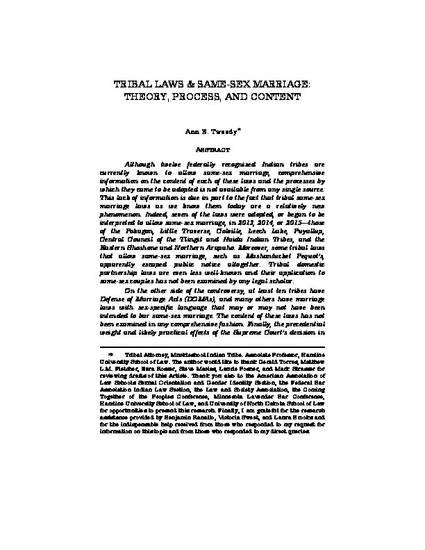
Article
Tribal Laws & Same-Sex Marriage: Theory, Process, and Content
46 Columbia Human Rights Law Review 104
(2015)
Abstract
Although twelve federally recognized Indian tribes are currently known to allow same-sex marriage, comprehensive information on the content of each of these laws and the processes by which they came to be adopted is not available from any single source. This lack of information is due in part to the fact that tribal same-sex marriage laws as we know them today are a relatively new phenomenon. Indeed, seven of the laws were adopted, or began to be interpreted to allow same-sex marriage, in 2013, 2014, or 2015—those of the Pokagon, Little Traverse, Colville, Leech Lake, Puyallup, Central Council of the Tlingit and Haida Indian Tribes, and the Eastern Shoshone and Northern Arapaho. Moreover, some tribal laws that allow same-sex marriage, such as Mashantucket Pequot’s, apparently escaped public notice altogether. Tribal domestic partnership laws are even less well-known and their application to same-sex couples has not been examined by any legal scholar. On the other side of the controversy, at least ten tribes have Defense of Marriage Acts (DOMAs), and many others have marriage laws with sex-specific language that may or may not have been intended to bar same-sex marriage. The content of these laws has not been examined in any comprehensive fashion. Finally, the precedential weight and likely practical effects of the Supreme Court’s decision in United States v. Windsor on tribal law have not yet been analyzed in legal scholarship.
This Article addresses all of these issues, making it a unique source of information on, and legal analysis of, tribal law and federal law relating to marriage equality. Based on original interviews and correspondence with tribal members, tribal employees, and members of same-sex couples who have married under tribal law, as well as other sources, this Article concludes that tribal laws allowing same-sex marriage appear to be largely the result of grassroots efforts by tribal members. This pathway to marriage rights contrasts sharply with the early methods for adopting such laws among U.S. states. The first states to adopt marriage equality legislation did so through judicial decision, with other states following later via legislative action.
Tribal domestic partnership laws of varying scope are also examined, as are tribal DOMAs and other sex-specific marriage laws. The available information on tribal DOMAs suggests that tribes are often influenced by political developments at the state and federal levels in adopting DOMAs. Although, under federal law, Windsor has limited precedential effect on tribes, this difference in process and motivation between tribal laws allowing same-sex marriage and those banning it suggests that tribal courts should scrutinize tribal DOMAs carefully and that, when applying the Indian Civil Rights Act of 1968 (ICRA), they should look for solid evidence of tribal custom and tradition to support a tribal DOMA. Another reason that tribal courts should view same-sex marriage bans with suspicion is that such bans reflect a heteronormative conception of the nuclear family that has been historically imposed on tribes by the U.S. government and other colonial forces and that continues to be imposed to some degree today.
Disciplines
Publication Date
2015
Citation Information
Ann E. Tweedy, Tribal Laws & Same-Sex Marriage: Theory, Process, and Content, 46 Colum. Hum. Rts. L. Rev. 104 (2015)
